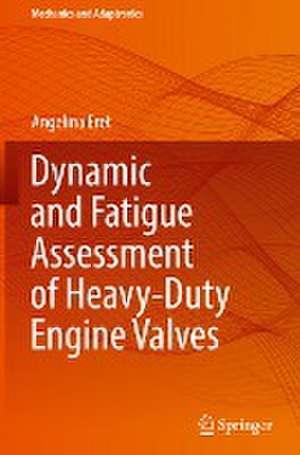Dynamic and Fatigue Assessment of Heavy-Duty Engine Valves: Mechanics and Adaptronics
Autor Angelina Ereten Limba Engleză Hardback – 3 ian 2024
Preț: 892.90 lei
Preț vechi: 1088.90 lei
-18% Nou
Puncte Express: 1339
Preț estimativ în valută:
170.86€ • 182.70$ • 142.46£
170.86€ • 182.70$ • 142.46£
Carte disponibilă
Livrare economică 27 martie-10 aprilie
Preluare comenzi: 021 569.72.76
Specificații
ISBN-13: 9783031491504
ISBN-10: 3031491505
Pagini: 162
Ilustrații: XXVII, 162 p. 74 illus., 66 illus. in color.
Dimensiuni: 155 x 235 mm
Greutate: 0.5 kg
Ediția:1st ed. 2024
Editura: Springer Nature Switzerland
Colecția Springer
Seria Mechanics and Adaptronics
Locul publicării:Cham, Switzerland
ISBN-10: 3031491505
Pagini: 162
Ilustrații: XXVII, 162 p. 74 illus., 66 illus. in color.
Dimensiuni: 155 x 235 mm
Greutate: 0.5 kg
Ediția:1st ed. 2024
Editura: Springer Nature Switzerland
Colecția Springer
Seria Mechanics and Adaptronics
Locul publicării:Cham, Switzerland
Cuprins
Introduction.- Theoretical Principles.- State of the Art.- Valve Dynamic Investigations & Measurements.- Application.- Conclusion and Outlook.
Notă biografică
Angelina Eret studied mechanical engineering at the Technical University in Berlin. At MAN Energy Solutions SE in Augsburg, she completed her doctorate in collaboration with the Technical University of Braunschweig with a thematic focus on the dynamics and strength of charge exchange valves of heavy-duty engines. Since July 2022, she has been working as a development engineer in the field of semiconductor manufacturing technology.
Textul de pe ultima copertă
This book provides findings on the simulation of the valve dynamic to the current technological standards. Above all, it delivers a simulation based and predictive approach on the fatigue strength assessment of four-stroke heavy-duty engine valves. The demand for more efficient combustion engines with fuel flexibility goes along with increasing component requirements regarding strength and durability, while the development costs should remain low. In this context, the present book focuses on the gas exchange valves of heavy-duty engines. Especially, the valves on the exhaust side have an increased risk of fatigue failure. The aim of this book is the generation of a predictive fatigue strength assessment to strengthen the frontloading of the exhaust valve design process and to increase the reliability of the component. In the context of fatigue assessment, this book examines the loads of the exhaust valve during its working cycle. Beside the high temperature and cylinder pressure, further loads act on the exhaust valve like actuation force or an eccentric impact of the valve on the valve seat ring. Furthermore, a bold valve secondary dynamic in the form of valve bending vibrations is observed on the exhaust valves of heavy-duty engines increasing the valve load even more. The cause of this secondary dynamic is unknown. This book investigates the valve loads to get the necessary input for the fatigue strength assessment. With respect to a predictive approach, the determination of valve dynamic and valve loads is based on a multibody simulation model of the valve train. In order to deliver predictive results and a transferable method, this simulation model includes all relevant physical effects to describe the valve dynamic accurately during all valve load phases of the working cycle. With the simulation model, the root cause for the bold valve secondary dynamic is examined iteratively. The model delivers not only the cause for the valve secondary dynamic but most importantly the critical valve loads. These loads deliver the input for the fatigue strength assessment. To ensure the robustness of the load data determined by the simulation model, the sensitivity of influences on the valve load is examined. In this context geometrical misalignment, fluctuations in load data and variable engine operation points are considered. A load collective based on the variation of influences on the valve load is the result of this analysis. All the results of the influence and sensitivity study are generated with the newly developed simulation model of the valve train. Moreover, this book outlines measurements on a testbed engine. In scope of these measurements are temperature and strain measurements of the valve. The generated data validate the simulation model of the valve train. Additionally, the statistical evaluation of the data is used in the subsequent fatigue strength assessment to increase the reliability of the results.
Caracteristici
Provides a predictive and simulation based method of fatigue assessment of exhaust valves Presents a detailed investigation of the exhaust valve secondary dynamic Explains valve train measurements on a fired engine testbed and its statistical evaluation regarding valve load









